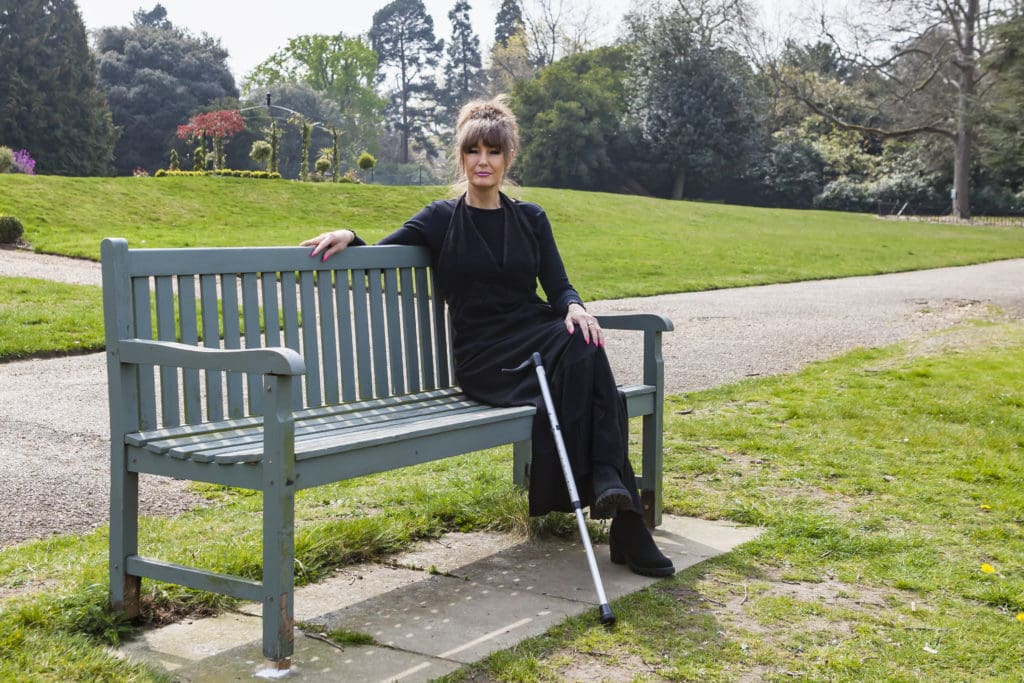Tina’s story: Pain after spinal cord injury
23 September 2019

Like many people with a spinal cord injury, I have two types of pain: neuropathic and nociceptive. For anyone new to these terms, neuropathic pain is caused when the nervous system is damaged. Nociceptive pain is the type of discomfort we feel if we break a wrist or stub a toe etc.
My injury level is from C4-C7, the upper part of the spine. I ended up more or less completely paralysed for a while because my injury level was so high. Over time, I regained more sensation and progressed from using a wheelchair to a Zimmer frame. I now only need a walking stick on occasion.
I have metal rods in my neck, and it is around this area as well as the location of the injury itself where I have quite severe pain. My neuropathic pain, however, can be felt in both knees and feet, and down my right side, which is weaker.
Both types of pain are unique and can be excruciating at times. I am on medication to help with the neuropathic pain, and I tend to take Paracetamol for the pain in my neck.
But the medication only coats the pain, so I’ve spent a lot of time working out how else I can manage it in day-to-day life.
Over this last year, I’ve discovered that walking really helps with the neuropathic pain. However, the side effect of this is that my neck pain is much worse afterwards. I don’t want to give up on my walking, so I really do try to just stay within my limits.
I would say that, for me, distraction really is key to my pain management. I’ll try to lose myself in a movie or write – sometimes even interacting on Twitter helps. There are obviously some days when I find it difficult to do these things. However, I know the pain will at some point subside. It’s like a little cycle that goes around and around and sometimes bed rest (when possible) is the only answer.
It’s only very recently that I’ve opened up about my pain, and this is all thanks to my mentor Neil at Back Up. He has a similar injury level and pain symptoms, so I could speak openly and honestly to him. This, in turn, helped me to be more open with my friends and family. They were surprised when I told them that I struggle with pain. Neil has helped me to realise that I’m not being ungrateful if I talk about the pain. It is after all very real to me.
I would suggest to anyone experiencing pain to talk about it. If you can’t talk to friends and family, I would definitely talk to a member of staff at Back Up. I’ve found that they always have a listening ear and have helped me no end.
I now acknowledge the different types of pain and try to keep track of what may trigger them. If you have pain in your neck, one piece of equipment I would thoroughly recommend is a stand for your laptop. I can spend a long time on my computer, and so having it raised to eye level is a real benefit. I’m no longer straining my neck, my weakest point, by looking down.
I’m still adapting to the little day to day things which I so easily did before. Carrying heavy objects isn’t possible, so shopping can pose a problem. I had to swallow my pride and buy a shopping trolley, but my life has changed for the better as a result. I wouldn’t be without it now. Even getting the laundry downstairs was a problem in the beginning. Now I just throw it all downstairs and fill a lightweight laundry bag and drag it to the washing machine. It’s not very elegant, however, it saves any painful strain on my neck.
Since leaving hospital, properly managing my pain has been a real case of trial and error.
I try to research everything now – even how lightweight a crossover shoulder bag will be so that I get exactly what I need. Research is absolutely crucial.
Thankfully, I’ve come to know my own body better and so managing my pain after spinal cord injury has become easier over time. Talking about it, taking my medication on time, research, walking, and distraction are the five key things I do to keep my pain in check. Realising that there are people who understand, and who have also been through what I’ve experienced, has helped me no end. I would not be where I am today if it hadn’t been for Back Up’s support.
Do you experience pain after spinal cord injury? You can read our online resource on how to manage it in day-to-day life or speak to a member of our outreach and support team on 020 8875 1805 to find out what other support is available.


